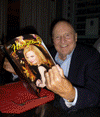 |
This is the time of year when provocative movies are released—the type you wish you could see all year long. Memoirs of a Geisha is the long-awaited adaptation of the best-selling, same-titled 1999 novel by Arthur Golden, based on the real life of geisha Mineko Iwasaki. The film was originally to be directed by Steven Spielberg. Instead, Spielberg, the executive producer, gave the nod to Rob Marshall (behind the lens of the 2002 film, Chicago).
The story begins in 1929, when Chiyo, a beautiful, nine-year-old girl from a Japanese fishing village is sold by her impoverished father to a Kyoto geisha house. She is first treated harshly, then finds a mentor, and is eventually launched into the elite society of pre-World War II Japan as the elegant geisha, Sayuri. Some of the dialogue is unintelligible, since half the cast learned English phonetically. Still, the film is deeply absorbing, due in no small part to the Chinese-born title player Ziyi Zhang.
Dame Judi Dench could win her second Oscar for her title role in Mrs. Henderson Presents. She portrays the wealthy widow with a daring spirit who, in 1937, bought and restored the Windmill Theater in London’s West End. In a stroke of theatrical genius, Henderson launched a 24-hour female revue (“never closed, and never clothed!”). Christopher Guest plays the conservative Lord Chancellor, who finally decrees that if the girls stand still—in themed tableaux—the performances can be classified as “art.”
Co-star/executive producer Bob Hoskins is the flamboyant Vivian Van Damm, the Dutch-born Jewish impresario hired to run daily operations. The Cockney actor, with swirled pompadour, presents a delightful screen persona, as the two clash, engage, and admire each other—against the gathering clouds of World War II.
Director Stephen Frears (The Grifters) has directed Dame Judi before (in the 1983 TV production Saigon: Year of the Cat). As Mrs. Henderson, she is feisty, yet almost regal—a bohemian who cared deeply about the girls she employed. This wonderful musical-drama gives belated glory to a strong character from that period.
Dame Joan Plowright (a.k.a. Lady Olivier) is another luminous figure of British stage and screen (stellar in Tea with Mussolini and Enchanted April). In the title role in Mrs. Palfrey at the Claremont, directed by Dan Ireland, she, too, portrays an independent widow—who has moved to a dreary residential London hotel. Mrs. Palfrey’s grandson never returns her calls, leading the other elderly residents to frankly wonder if he even exists. Then, she asks a struggling young writer to impersonate her grandson—so that she can save face. Thus begins a touching May/December friendship, which goes far beyond any affection she might have had for a true blood relative.
Ms. Plowright conveys many emotions, relying solely on her expressive eyes—tapping her extensive stage background. Throughout the film, she maintains the character’s dignity, determination, and strong spirit. The other hotel residents are shown mostly in glimpses, used as devices to develop more of Mrs. Palfrey’s character. Rising star Rupert Friend (most recently cast as the officer, Mr. Wickham, in Pride & Prejudice) is perfect as the ersatz grandson. With him on her arm, Mrs. Palfrey quickly becomes the envy of all. This is a charming, intimate, albeit stark film.
Sir Anthony Hopkins, yet another titled British subject, plays an eccentric old adventurer in The World’s Fastest Indian, directed by Australian Roger Donaldson (director of Hopkins’ 1984 film, The Bounty). The film celebrates the inspiring true story of New Zealander Burt Munro, whose lifelong dream was to race at the famous Bonneville Salt Flats in Utah, site of numerous land-speed world records. In the late 50s, after years spent assembling a rickety 1920 Indian motorcycle built from spare parts, he hops a tramp steamer for America, without support crew or sponsor. Hopkins’ Burt Munro is as oblivious as Paul Hogan’s 1986 character, Crocodile Dundee, and Peter Seller’s Chauncey Gardiner in the 1979 film, Being There. Yet unlike the others, Munro makes a legendary journey of self-discovery and determination. It is a bravura performance.
Arriving in theatres in February, Sophie Scholl is the riveting, true story of the final six days in the life of a brave member of the “The White Rose,” a clandestine resistance group of young German students who opposed Hitler and The Third Reich. In Munich, in 1943, the Gestapo arrest Sophie (Julia Jentsch) and her brother, Hans (Fabian Hinrichs), for leaving leaflets at the university. Jentsch is sensational, particularly while enduring days of harsh interrogation—the heart of the movie. The quick trial that follows includes a screaming diatribe from the tribunal’s chief judge, a fanatical Nazi. The Scholls were executed the same day the verdict was rendered, but not before a heartbreaking farewell scene with their parents. Other films have been made about “The White Rose,” but none as powerful in recreating the savagery of Nazi justice.
If this early 2006 release is typical of what is to come, a good new year of movies awaits!
Jeffrey Lyons has been a film critic since 1970 and has reviewed nearly 15,000 movies and 3,000 plays. The son of Broadway columnist Leonard Lyons, whose “The Lyons Den” was the most respected column of its day (1934-1974), he is the critic at WNBC-TV, and is seen on 200 NBC stations. His “Lyons Den” radio reports are heard on more than 100 stations nationwide.
|




